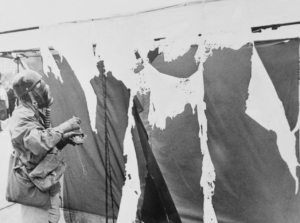
Metzger (1961) painting three nylon curtains, causing them to be permanently destroyed.
While this is less of a single art piece and more of a small movement, Auto Destructive Art (ADA) was an important aspect of German Art Culture in the early 1960s. Gustav Metzger, the founder of the movement, sought to exemplify the destructive capabilities of “modern” technology through his work, often in rather radical ways.
Metzger, who was often associated with multiple environmentalist, antifascist, and anarchist groups in Germany, used his self-created movement to protest nuclear proliferation during the Cold War. His medium, along with the “Group of 100” ,as the other ADA painters were known, was to paint using acid and other corrosive materials on nylon canvases that altered the pieces while they were being created (Tate Gallery).
Auto-destructive art is inherently political. According to Metzger’s thought, the world was too highly fixated on a morbid love of destruction. Along with that, he believed that humans rely too heavily on technology, which has untold consequences on human existence.
After a few years of working with other ADA artists, Metzger decided that a manifesto detailing the requirements of what a piece needs to do in order to be considered true ADA was in order. To be considered true ADA, a piece must “return to its original state of nothingness” within 20 years, the piece must continue to develop after the artist is finished (this was to avoid any sense of ownership being attached to the piece), and each work must be completed in a public space to allow public participation with each individual piece (Tate Gallery).
These requirements were tantamount to the movement’s effectiveness. The whole point of the movement was to inspire the public to embrace natural growth, development, and movement towards the future (Radical Art).
While the movement in its original form struggled to maintain relevance for long, several aspects of it have managed to influence contemporary artists, some being rather notable. The most relevant modern piece with ADA influences was Banksy’s 2006 work, Girl With A Balloon, which was shredded before an audience in 2018. In this case, the influence was the impermanence of art (Oxford Student). The piece was put through a paper shredder before an unknowing audience, many of whom had placed bids on the piece during the auction of it directly before its shredding.
To conclude, Auto-destructive Art falls into the broader category of counterculture art. It is art that not only displays the creative prowess of the artist, but also displays a message that challenges the traditional beliefs of society.
Works Cited:
2019, Culture·13th January, and Pratibha Rai. “The Curious Case of Auto-Destructive Art.” The Oxford Student, January 13, 2019. https://www.oxfordstudent.com/2019/01/13/the-curious-case-of-auto-destructive-art/.
“Auto-Destructive Art.” Auto-destructive art. Accessed April 24, 2023. http://radicalart.info/destruction/metzger.html.
Tate. “Auto-Destructive Art.” Tate. Accessed April 24, 2023. https://www.tate.org.uk/art/art-terms/a/auto-destructive-art.
